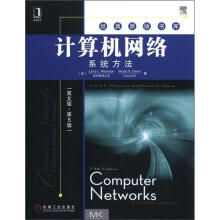经典原版书库:计算机网络·系统方法(英文版·第5版)
作者:(美)彼得森,(美)戴维 著
出版:机械工业出版社 2012.4
页数:884
定价:139.00 元
ISBN-13:9787111377207
ISBN-10:7111377206
去豆瓣看看 Foreword
Foreword to the First Edition
Preface
1 Foundation
Problem: Building a Network
1.1 Applications
1.1.1 Classes of Applications
1.2 Requirements
1.2.1 Perspectives
1.2.2 Scalable Connectivity
1.2.3 Cost-Effective Resource Sharing
1.2.4 Support for Common Services
1.2.5 Manageability
1.3 Network Architecture
1.3.1 Layering and Protocols
1.3.2 Internet Architecture
1.4 Implementing Network Software
1.4.1 Application Programming Interface(Sockets)
1.4.2 Example Application
1.5 Performance
1.5.1 Bandwidth and Latency
1.5.2 Delay x Bandwidth Product
1.5.3 High-Speed Networks
1.5.4 Application Performance Needs
1.6 Summary
What's Next: Cloud Computing
Further Reading
Exercises
2 Getting Connected
Problem: Connecting to a Network
2.1 Perspectives on Connecting
2.1.1 Classes of Links
2.2 Encoding (NRZ, NRZI, Manchester, 4B/5B)
2.3 Framing
2.3.1 Byte-Oriented Protocols(BISYNC,PPP,DDCMP)
2.3.2 Bit-Oriented Protocols (HDLC).
2.3.3 Clock-Based Framing (SONET)
2.4 Error Detection
2.4.1 Two-Dimensional Parity
2.4.2 Internet Checksum Algorithm
2.4.3 Cyclic Redundancy Check
2.5 Reliable Transmission
2.5.1 Stop-and-Wait.
2.5.2 Sliding Window
2.5.3 Concurrent Logical Channels
2.6 Ethernet and Multiple Access Networks (802.3)
2.6.1 Physical Properties
2.6.2 Access Protocol
2.6.3 Experience with Ethernet
2.7 Wireless
2.7.1 802.11/Wi-Fi
2.7.2 Bluetooth(802.1 5.1 )
2.7.3 CeLIPhone Technologies
2.8 Summary
What's Next: "The Internet of Things"
Further Reading
Exercises
3 Internetworking
Problem: Not All Networks are Directly Connected
3.1 Switching and Bridging
3.1.1 Datagrams
3.1.2 VirtuaI Circuit Switching
3.1.3 Source Routing
3.1.4 Bridges and LAN Switches
3.2 Basic Internetworking (IP)
3.2.1 What Is an Internetwork?
3.2.2 Service Model
3.2.3 Global Addresses
3.2.4 Datagram Forwarding in IP
3.2.5 Subnetting and Classless Addressing
……
4 Advaned Internetworking
5 End-to-End Protocols
6 Congestion Control and Resource Allocation
7 End-to-End Data
8 Network Security
9 Applications
Larry L. Peterson,普林斯顿大学副校长,计算机科学系Robert E. Kahn教授,并且还是Verivue,Inc.首席科学家。他于1985年在普度大学获得博士学位,其研究方向主要是网络系统的设计与实现。
Bruce S. Davie,拥有英国爱丁堡大学计算机科学博士学位,于1995年加入Cisco公司,并于1998年被授予Cisco特别会员荣誉称号。他主持设计了MPLS协议,并开发了其他重要的因特网技术。Davie博士在加入Cisco之前曾担任贝尔通信研究公司的首席科学家。
《经典原版书库:计算机网络·系统方法(英文版·第5版)》是计算机网络方面的经典教科书,凝聚了两位网络专家几十年的理论研究、实践经验和大量第一手资料,自出版以来已经成为网络课程主流教材,被哈佛大学、斯坦福大学、卡内基一梅隆大学、康奈尔大学、普林斯顿大学等众多名校采用。
第5版秉承了前4版的特点,通过丰富的网络和协议设计实例,来阐述计算机网络关键原理。全书的重点在于“为什么这样设计网络”——不仅详细叙述当今网络系统的组成,而且还阐述关键技术和协议如何在实际应用中发挥作用,从而解决具体的问题。本版对内容进行了全面更新,覆盖P2P、无线技术、网络安全和应用等重要主题,更关注网络研究和设计中涉及的应用层问题。
比价列表








 缺书网
缺书网 扫码进群
扫码进群